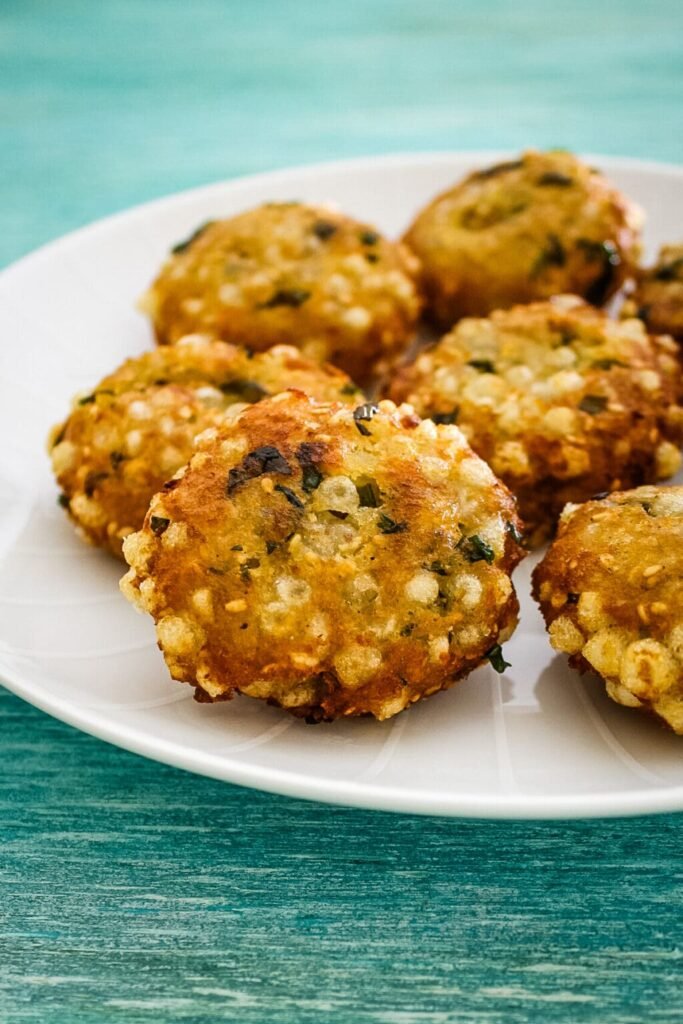Craving something deliciously crispy on the outside and soft, melt-in-your-mouth tender on the inside? Look no further! This sabudana vada recipe is your go-to solution for a traditional yet incredibly satisfying snack. Perfect for fasting days or just when you’re in the mood for something indulgent, these golden beauties deliver the ideal balance of crunch and comfort.
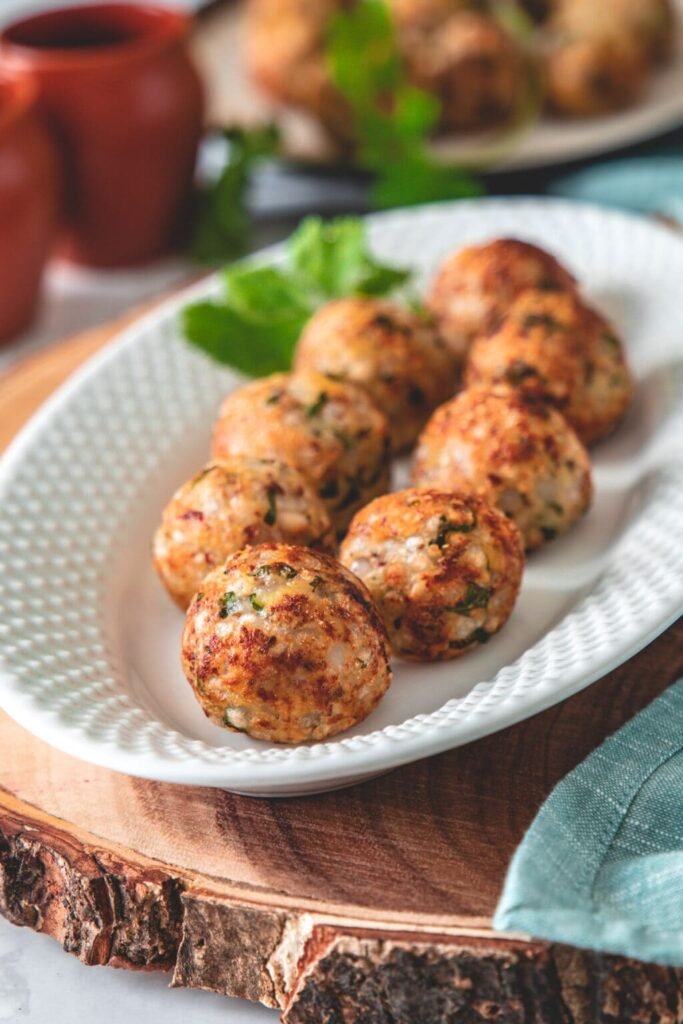
In this post, I’ll walk you through how to make the perfect sabudana vada that turns out crispy every single time. Whether you’re a beginner or a seasoned cook, I’ve included all my tried-and-true tips, secret tricks, and common mistakes to avoid — so you can fry with confidence. Trust me, once you master this method, you’ll never look at soggy or oily vadas the same way again!
If you’re aiming for a lighter and healthier version, there’s no need to miss out — I’ve included a nutritious alternative you’re going to love! Scroll down to find the step-by-step instructions and video for making the non-fried version as well. With simple ingredients and a foolproof method, these air-fried or pan-fried sabudana vadas are just as delicious, with significantly less oil.
So, whether you’re preparing for a festive occasion, observing a fast (vrat), or simply want to enjoy a delicious Indian snack, this detailed guide will help you nail it every time.
You’ll Love This Sabudana Vada Recipe
Sabudana vada is not just a delicious snack; it holds a special place in many Indian households, especially during religious fasting days such as Navratri, Ekadasi, Maha Shivratri, and Janmashtami. These crispy delights are commonly enjoyed during vrat (fasting) because they provide a great source of energy while adhering to fasting food restrictions.
If you’ve ever visited Mumbai, you’ll know that sabudana vada is a popular street food staple. The bustling local stalls lining the streets of the city serve up piping hot, golden vadas that are beloved by both locals and tourists alike. This recipe brings that authentic Mumbai street food experience right into your kitchen. It captures the same flavors and textures that you’d savor from those iconic roadside vendors, making it perfect for anyone craving that classic taste.
Fried (Authentic) Version:
The traditional way to prepare sabudana vada is by deep-frying, and this method delivers an unbeatable combination of crispy exteriors and tender, fluffy interiors. These vadas develop a satisfying crunch as you bite into them, immediately followed by a soft, melt-in-the-mouth texture that’s simply irresistible. The contrast in textures is what makes this recipe stand out.
However, it’s important to note that freshly fried sabudana vadas are at their best right out of the oil. As they cool, they tend to lose some of their crispiness, so serving them hot ensures the best experience.
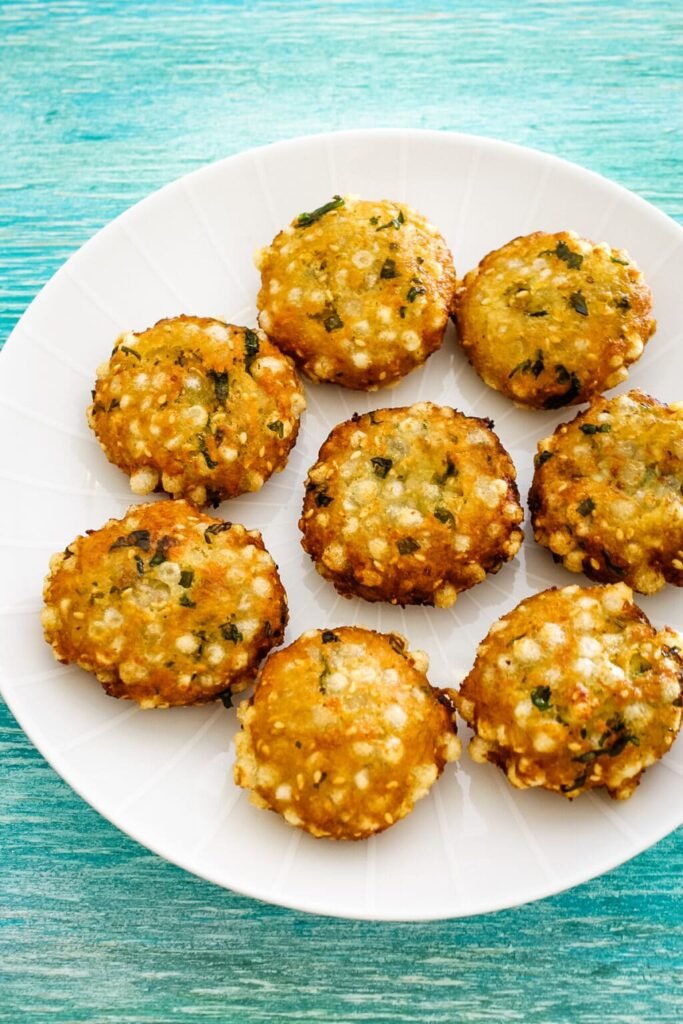
Non-Fried Version:
For those who prefer a lighter option or want to reduce their oil consumption, the non-fried sabudana vada is an excellent alternative. Instead of deep frying, this version is cooked in a paniyaram pan (also known as an aebleskiver pan), which requires only a small amount of oil — roughly 1 to 1.5 teaspoons per vada. This method uses much less oil while still achieving a nicely crisp outer layer.
The level of crispiness in these pan-cooked vadas largely depends on how much oil you use. The quantity mentioned provides a moderate crunch on the outside, while maintaining the soft, tender inside that sabudana vada is famous for. This healthier version is perfect for those looking to enjoy their favorite snack without the guilt of deep frying, and it’s equally satisfying in flavor and texture.
Ingredient Notes
Then’s a print showcasing the simple yet essential constituents used to prepare authentic sabudana vada( note the oil painting used for deep frying isn’t shown in the picture). Although the component list is straightforward, each element plays a vital part in creating the succulent, scrumptious vadas that everyone loves.
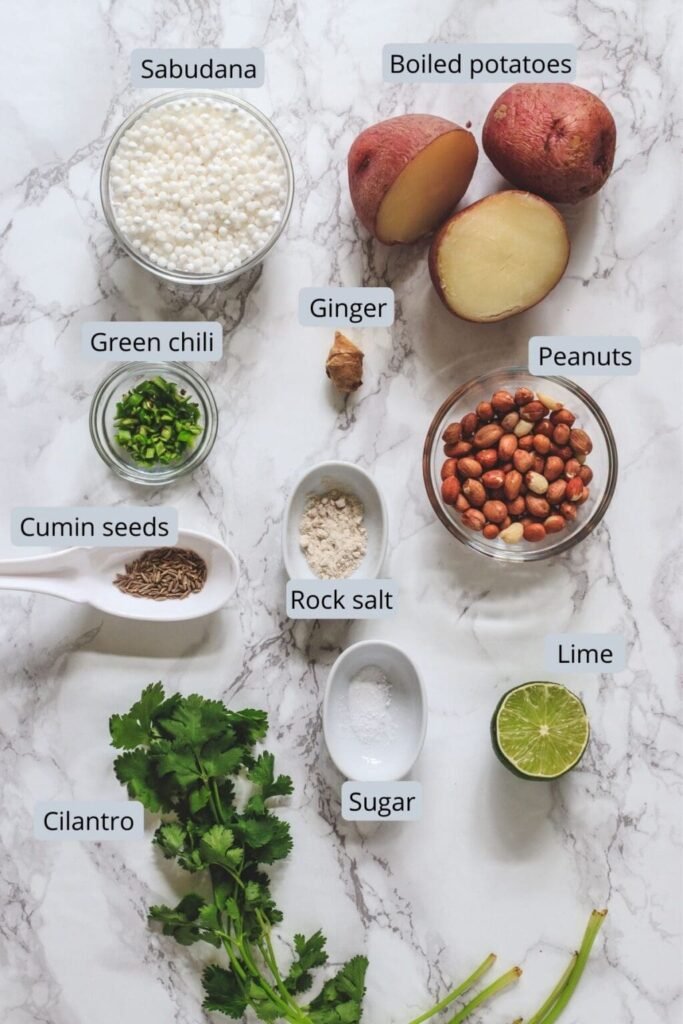
- Sabudana: Also known as tapioca plums in English, sabudana is primarily composed of pure bounce and is rich in carbohydrates. It’s a popular component during Hindu fasting( vrat) because it provides long-lasting malnutrition and a quick boost of energy, perfect for sustaining you through the day without breaking your fast.
- Potato: Boiled and mashed potatoes are included in the admixture to serve as a natural list agent, helping the vada hold its shape during frying. For the stylish texture and taste, I largely recommend using red potatoes or Yukon Gold potatoes, as they’ve a delicate thickness and subtle flavor that rounds Indian dishes beautifully.
- Peanuts: Coarsely crushed peanuts add both nutrition and a pleasurable crunch to the sabudana vada. They introduce a nutty flavor that balances the mildness of the tapioca plums and enhances the overall texture.
- Ginger: Fresh ginger adds a subtle warmth and depth of flavor to the vada. Still, since gusto consumption varies during vrat among different families and traditions, feel free to forget or include it, grounded on your particular or family customs.
- Green Chili: This is the only component responsible for the heat and spiciness in the vada. Acclimate the volume according to your preference to get just the right position of kick that suits your palate.
- Rock Salt( Sendha Namak): Because sabudana vada is generally prepared during fasting, sendha namak( gemstone salt) is used rather of regular salt. This salt is allowed during fasting and lends a unique flavor to the dish. On regular days when you’re not dieting, you can simply substitute it with regular table salt to suit your taste.
How To Make Sabudana Vada?
Preparation:
- Start by putting the sabudana (tapioca pearls) into a fine strainer and rinse well under cold running water. Continue washing until the water runs clear to remove excess starch, This step is crucial because leftover starch can cause the vada mixture to become overly sticky and difficult to work with.
- Then, immerse the rinsed sabudana in sufficient water and let it soak for 3 to 4 hours, or preferably overnight, depending on the variety and brand you have. For example, the variety commonly found in the USA usually requires a longer soaking time, typically overnight, to soften properly.
- After soaking, the sabudana will have swollen, absorbing most of the water and nearly doubling in size. Transfer them back to the colander and let them drain for 15 to 20 minutes so that excess moisture escapes. Removing as much water as possible is essential because too much moisture will make the mixture loose and hard to shape.
- To check if your sabudana has been soaked correctly, gently press a few pearls between your fingers — they should mash easily and not feel hard or grainy.
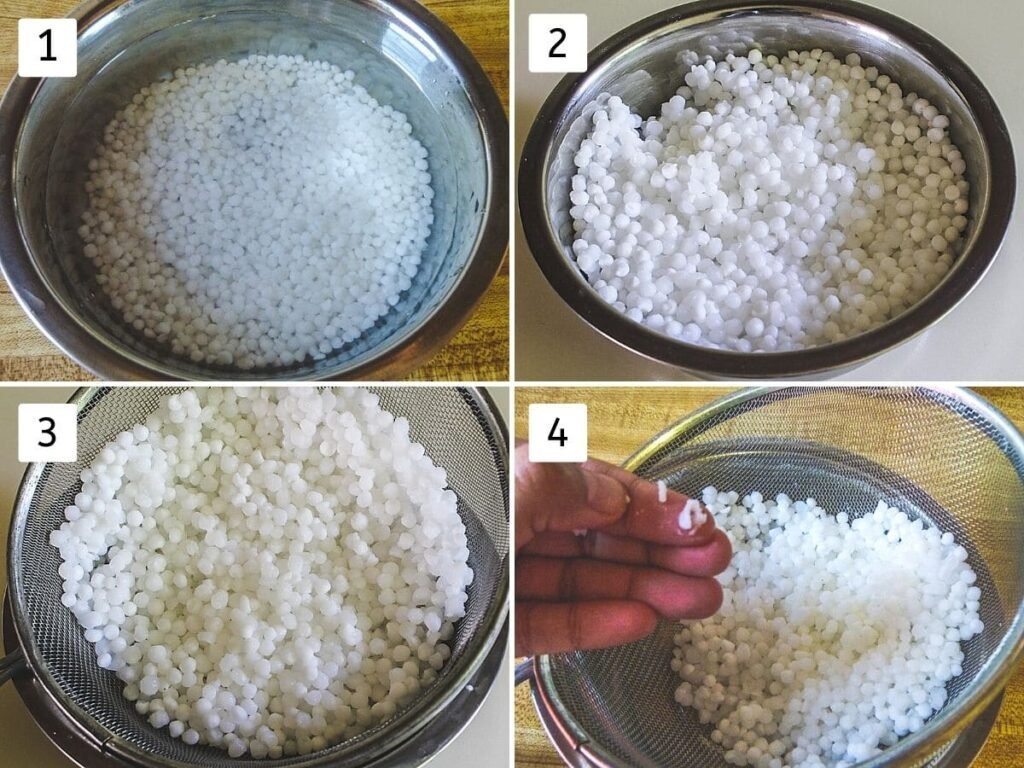
- As the sabudana drains, roast raw peanuts in a dry skillet over medium-low heat until they become lightly golden and release a fragrant, nutty smell.
- Let the roasted peanuts cool completely before roughly crushing them. I prefer using a mortar and pestle for this because it gives me chunky pieces that add a wonderful texture to the vada. You may also use a food processor or grinder, but be careful, as these can sometimes pulverize the peanuts into powder rather than crush them.

Making Sabudana Vada (Fried Version):
- Mix all the ingredients together thoroughly in a large bowl.
- Mix everything thoroughly to form a stiff, dough-like mixture. The consistency should be firm enough to shape into patties easily without falling apart or sticking to your hands. If the mixture feels too loose or sticky, add a tablespoon or two of rajgira (amaranth) flour or singhara (water chestnut) flour to help bind it better.
- Warm the oil in a deep frying pan over medium heat. Meanwhile, lightly coat your hands with some oil and form the mixture into small, flat, round patties. Place them on a plate and set aside.
- To ensure the oil is hot enough for frying, drop a small pinch of the sabudana mixture into the oil. If it rises steadily to the surface and starts to bubble, the oil is ready. If the piece sinks and stays at the bottom for a while, the oil needs more heating.
- Carefully slide the prepared vadas into the hot oil. Do not move or disturb them for the first minute to prevent breaking. After that, gently flip them over using a slotted spoon or spatula. Fry 3 to 4 vadas at a time, but avoid overcrowding the pan to maintain the oil temperature and ensure even cooking.
- Fry each side until the vadas turn a beautiful golden brown and become crisp.
- Use a slotted spatula to remove the vadas from the oil and transfer them to a plate lined with paper towels to drain excess oil. Repeat this frying process with the remaining vadas until all are cooked.
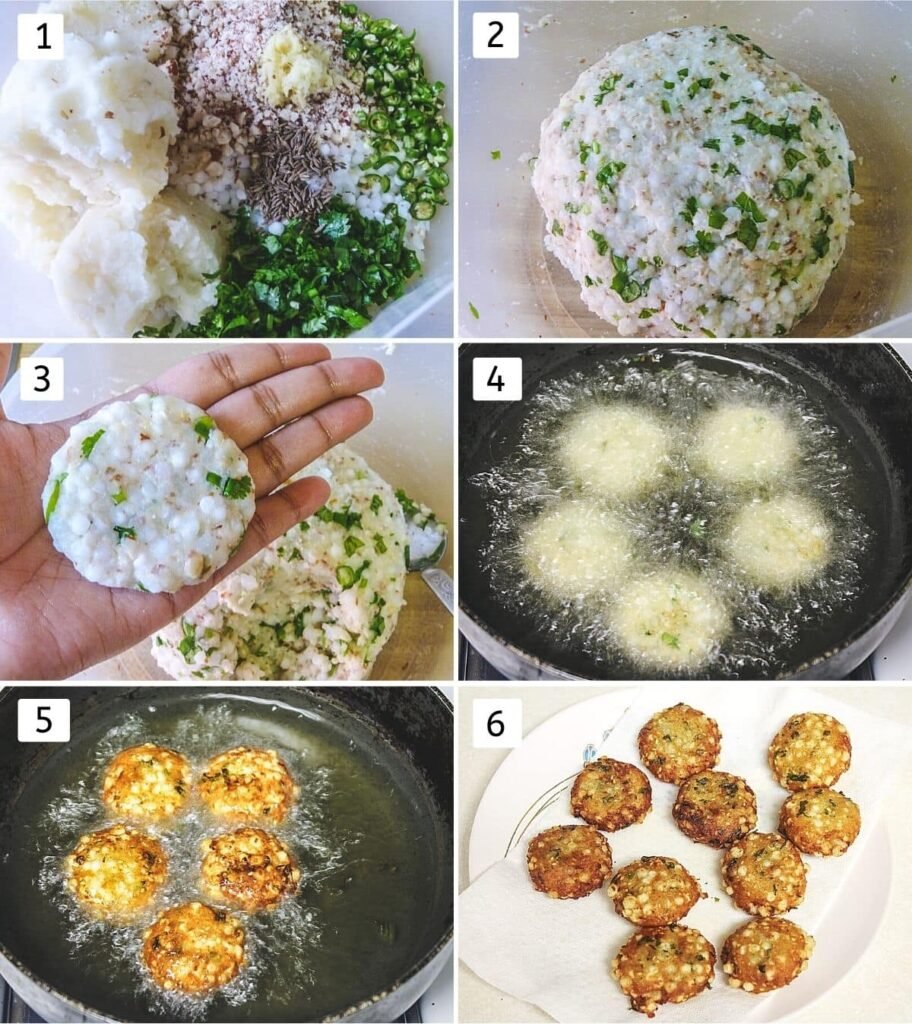
Non-Fried Sabudana Vada:
- Prepare the sabudana admixture as described over. Grease your triumphs smoothly with oil painting and shape the admixture into small balls. Each ball should be slightly lower than the indentation of your paniyaram or aebleskiver visage so that it fits comfortably in each depression.
- Toast the paniyaram visage over medium heat. Add roughly 1 tablespoon of oil painting to each section of the visage.
- Once the oil painting is hot, gently place one vada ball into each depression. Allow it to cook unperturbed until the bottom turns golden brown and develops a crisp crust.
- Precisely flip the vadas using a chopstick or rustic skewer. Drizzle a fresh half tablespoon of oil painting onto each vada and continue cooking until the other side also becomes golden and crispy. However, turn the vadas onto different sides to achieve an indeed golden- brown color on each around, if necessary.
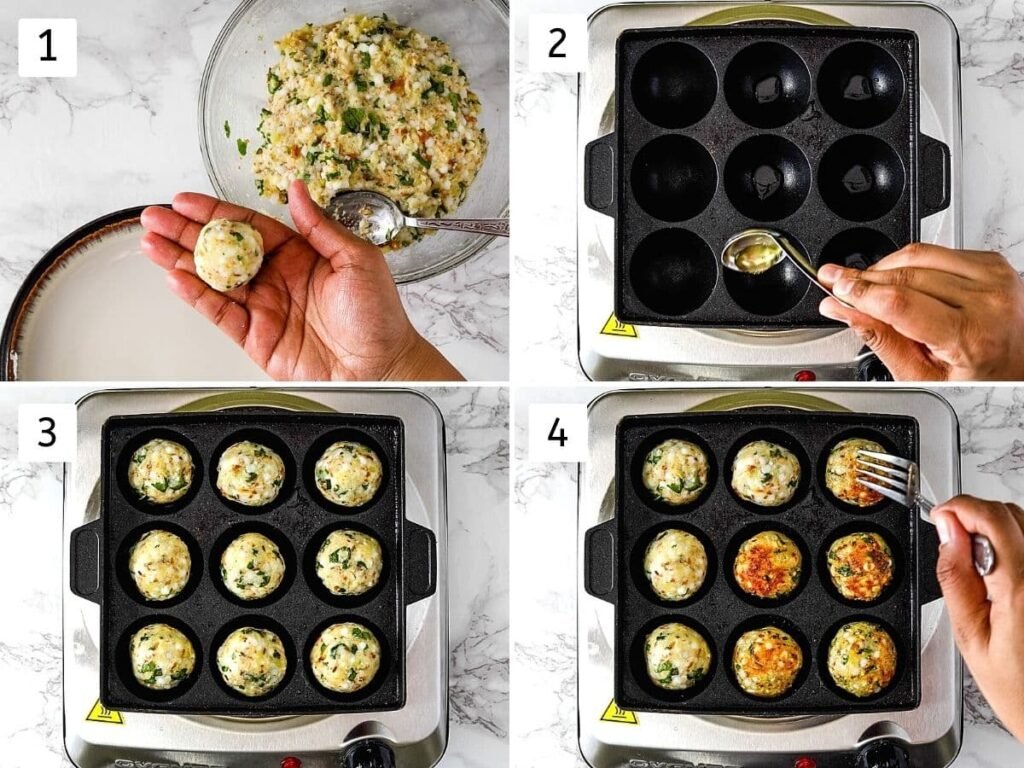
What To Serve With Sabudana Vada?
- Sabudana vada is best enjoyed when served hot or warm, as that’s when its outer crispiness and soft, melt-in-the-mouth interior truly shine. Once they cool down, they begin to lose that perfect crunchy texture, so it’s ideal to serve them fresh out of the fryer.
- Pairing these vadas with a flavorful chutney elevates the experience. A popular and vrat-friendly option is phalahari chutney, a light, herby dip made with ingredients allowed during fasting (upvas). It not only complements the taste but also enhances the dish’s authenticity for festive or religious occasions.
- On non-fasting days, sabudana vadas are incredibly versatile and go well with different dips. I personally love enjoying them with a bowl of creamy yogurt, and sometimes I switch it up with a tangy mint-coriander chutney or even a dash of ketchup for a modern twist.
- These vadas make an ideal snack to enjoy during the rainy season. There’s something comforting about munching on these golden delights while sipping on a steaming cup of chai or coffee as the rain pours outside — it’s a classic and cozy Indian snack-time moment.
